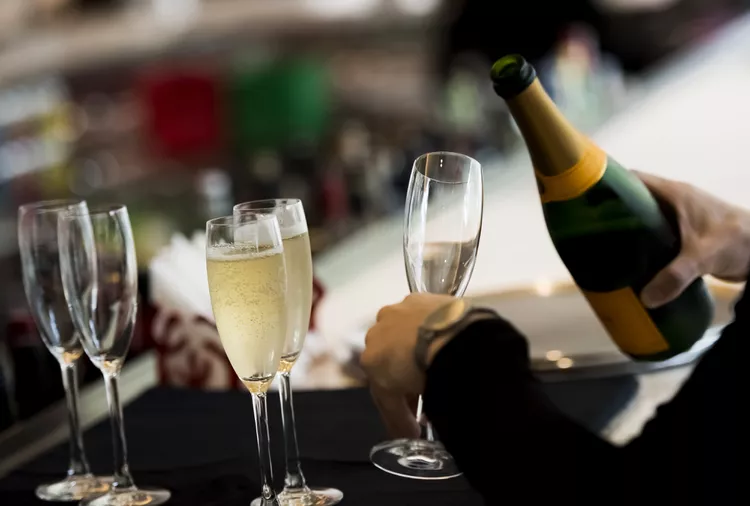The snap of a champagne cork is the auditory equivalent of saying, “Let’s get the party started.” Pop open a bottle of champagne and the room fills with lively bubbles before the liquid even touches your lips.
But sommeliers will be the first to tell you that you definitely don’t want to hear an unexpected loud pop when you pop open a bottle of champagne. If done incorrectly, opening a bottle of sparkling wine can result in a fizzy, fizzing, and less-than-pleasant bottle.
The soft, satisfying pop that comes with popping a bottle indicates that the person opening it is a professional. But you don’t have to be a sommelier to look like one. We consulted several champagne experts to guide us on how to properly open a bottle of champagne?
Chill the Bottle
Enjoying a perfect bottle of Champagne starts hours in advance. Start by placing the bottle in the fridge for at least two hours, or in a bucket of ice (try half ice, half water) for an hour.
Champagne should be served between 46°F and 50°F. Mathieu Roland-Billecart, CEO of Champagne House Billecart-Salmon and a seventh-generation family member, prefers to take the bottle out of the fridge 20 to 30 minutes before tasting and refrigerate it to get it down to optimal drinking temperature.
“It also depends on the temperature outside, though,” he says. Hot? Place the bottle near ice. Cold? The air helps keep it chilly.
If the bottle isn’t properly chilled, you can lose up to a third of its bubbles to popping.
“If the bottle isn’t cold enough, the CO2 particles inside become more active and eager to escape,” says Todd Johnston, beverage director and sommelier at Marsh House in Nashville, Tennessee. “This can cause an explosion and a flying cork.”
Try to avoid shaking or moving the bottle when you remove it from the fridge or ice bucket. This can also create bubbles.
Prepare the bottle
When the wine reaches optimal drinking temperature, slowly remove the foil and loosen the cage on the top of the bottle.
“I remove the foil before serving the bottle to the guest,” Johnston says. “I hold the cap with my thumb and pull the wire tab down six and a half turns counterclockwise, then use the same hand to loosen the bottom of the cap.”
But don’t remove the cage completely—it protects the cork if it pops out accidentally.
“I think this is the most efficient and safest way to open a bottle of sparkling wine,” says Brian Heath, CEO and owner of Heath Family Brands, a sparkling wine producer in the Texas Hill Country. “Hold the bottle and cork with one hand and loosen the cap.”
Keep the cap away from your face, friends, or anything else you don’t want to break. An erupting cork can fly at speeds of 50 miles per hour. It can cause serious damage. For extra precaution, place a towel over the cap to prevent accidental ejection.
Popular
Next, “hold the cork firmly with one hand and twist the base of the bottle. This makes it easier to open the bottle and gives you more control over the cork to reduce noise,” says Roland-Billecart. “For older vintages, this can make the rotation slower and prevent the cork from breaking.”
Johnston also starts by placing his palm over the cage and cork and twisting the base of the bottle until the cork begins to loosen.
“I let the cork come out slowly under my control, allowing the pressure and gas to release quietly without a pop,” he says. “You do need to apply a little force and control so the pressure from the cork doesn’t overpower you.”
If done correctly, there should be a gentle pop. “Tilt the cork slightly as you pull it out so you can hear the ‘kiss’ sound of the pressure being released,” says Heath.
What if your sparkling wine is under the cap? “It’s as easy to pop the cap as it is to pop a beer bottle, but it requires a little more care,” says Johnston. “Some undecanted natural wines tend to spill, so it’s a good idea to have a napkin and glass ready for pouring.”
It’s worth noting that these pro tips don’t require shaking, spraying the bottle, or hacking with a saber.
“Traditionally, it’s best to avoid making loud noises that might startle or distract your guests from their meal,” says Johnson. “In Nashville, bachelorette groups often enjoy the excitement and attention that comes with a loud pop.”
If you’re a Major League Baseball player and you took home a trophy? Or someone naming a yacht? Spray whatever you like.
Fill it up
After removing the cork, hold the bottle at an angle (preferably 45 degrees) for a few minutes to let the wine sit for a few seconds.
Then reach for the wine glass, keeping it at the same angle. “It’s important to tilt the glass so the wine pours down the side of the glass when pouring,” explains Roland-Billecart. “This helps retain the bubbles.”
Leaving the glass on the table isn’t a big deal, according to Johnson. “I never pick up a glass from the table to pour, even though some service professionals might suggest it. The key is to pour slowly and steadily.” He recommends cracking a few bottles of wine at home to perfect the pour.
The final step is simple: enjoy!
Related topics:


